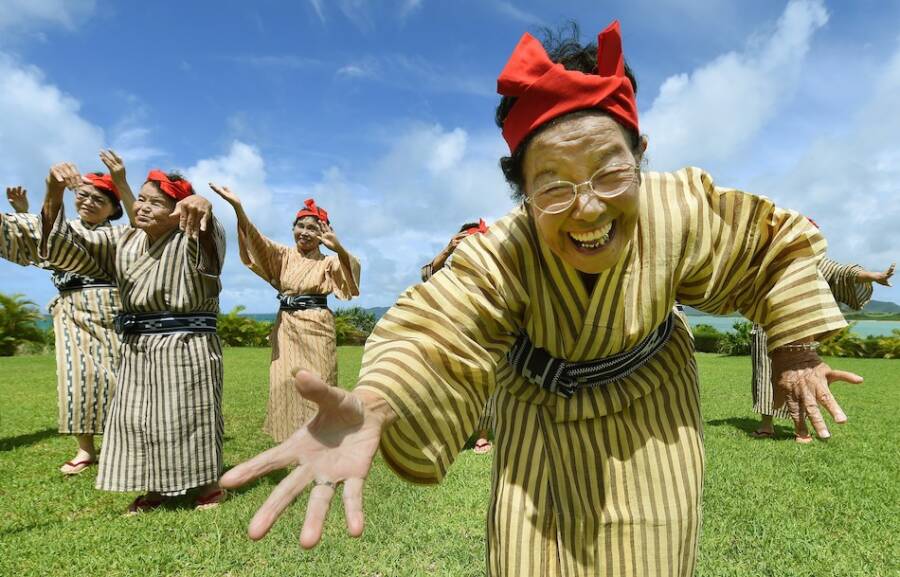These researchers noticed that the areas of the world with the highest concentrations of reported 110-year-olds actually had poor average lifespans and healthcare. It just didn't add up.

Toru Yamanaka/AFP/Getty ImagesA troupe of elderly women performs in Okinawa, Japan, one of the reported homes of a large number of the world’s supercentenarians.
In some parts of the world, there exist what are known as “blue zones.” These special areas — namely Okinawa in Japan, Sardinia in Italy, and Ikaria in Greece — reportedly host the highest concentrations of the world’s oldest people — supercentenarians, or individuals who make it beyond the very ripe old age of 110.
As these supercentenarians make headlines, they reveal their supposed secrets to such a long life, often leading to humorous pearls of wisdom that may sound counterintuitive, as in “Drink a glass of wine every day!” or “Never marry!”
And while all this sounds like a wonderful way to effortlessly live a healthy life well beyond your 90s, you might want to hold off on that daily glass of wine. A new study by Saul Justin Newman of the Biological Data Science Institute at Australian National University found that the reason why these blue zones exist might actually be poor record-keeping and fraud.
In other words, these supercentenarians might not be as old as we (or even they themselves) think.
For one thing, according to a report by Vox, supercentenarians are very rare. Only about one in 1,000 people who live to the age of 100 (making them a centenarian) actually make it to 110. By definition, a rare occurrence should be rare. If it isn’t, then that often means that something else is going on.
So how are there certain places like those in Japan, Italy, and Greece where there are seemingly so many supercentenarians clustered together?
Societies with high concentrations of supercentenarians would be expected to have other markers that would naturally go along with that high concentration, such as longer average lifespans in the population as a whole, high quality of life, and good healthcare. Instead, when looking closely at blue zones, researchers found the opposite: high crime, shorter lifespans, and poor healthcare.
What explains all this? The researchers suggest that misreports could be partially to blame, especially in places where there may have not been solid record-keeping. People could also have reported an incorrect age simply because they couldn’t remember, miscounted, or were told the wrong date of birth.
Another reason behind the possible overcounting of supercentenarians, researchers suggest, could be identity theft or fraud so that an individual may claim a pension or other financial gains.

Jean-Pierre Fizet/Getty ImagesJeanne Calment smoking a cigarette.
In fact, there have long been suspected cases of this. Earlier this year, a study of the life of French socialite Jeanne Louise Calment suggested that the 122-year-old supercentenarian, who died in 1997, was actually her daughter, Yvonne.
Indeed, the study suggested that her daughter Yvonne assumed the identity of her mother in order to avoid inheritance taxes. If true, that would cut down her age to 99 years old, not 122. However, evidence cited in the paper was largely circumstantial and the theory was never definitively proven.
The study’s suggestion of identity fraud has sparked some controversy among researchers, but it is not unheard-of and perhaps more common than we might think.
“The first two people to reach 112 were validated, then retracted. The first three people to reach 113 suffered the same fate,” Newman told Live Science. “The ways in which these errors can escape detection, even under interview, are diverse.”

Alexander Shcherbak/TASS via Getty ImagesThe study has found that some people recorded as supercentenarians may actually be younger and that things like poor record-keeping or identity fraud may be to blame.
Another significant piece of the study examined record-keeping in the U.S., where reliable birth records were introduced in different states at different times. Until about a century ago, many states simply didn’t have very good procedures in place.
But once solid record-keeping did start to become commonplace, researchers found that something interesting, if unsurprising, began to occur: As soon as a state started to keep proper records of its residents and their births, the number of supercentenarians dropped significantly by anywhere from 69 to 82 percent. That means for every 10 supposed supercentenarians, seven or eight of them were actually younger than they thought or claimed.
Whether shoddy records, fraud, or other factors are to blame, Newman’s research suggests that there are many ways someone could have a reported age that’s exactly incorrect. Who knows which of today’s “world’s oldest people” are actually all that they claim to be?
Now that you’ve learned about the supercentenarians who might be younger than we think, read about two people who’ve tried to claim the title of world’s oldest person in recent years: Mbah Gotho and Fredie Blom.





